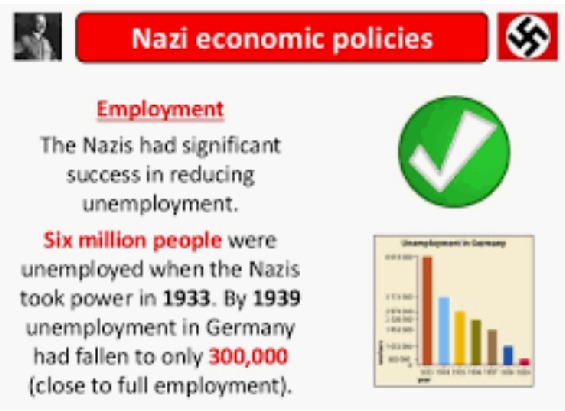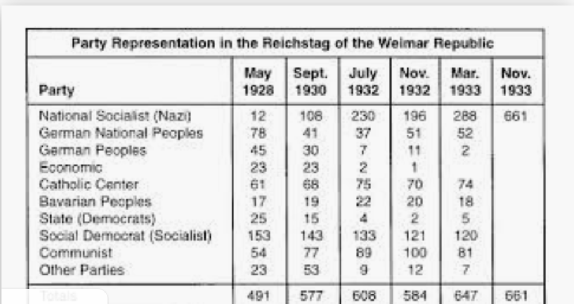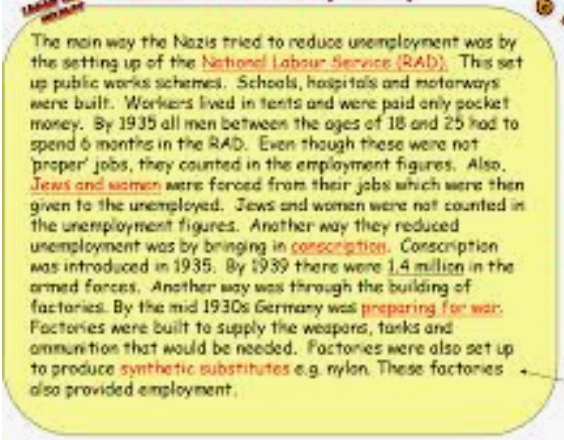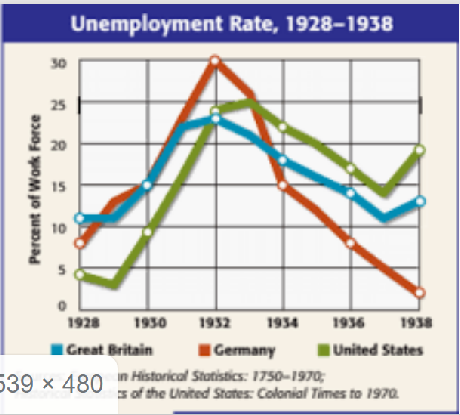|
CLICK BUTTON TO GO |
|
|
|
|
|
|
|
|
|
|
|
|
|
Videos |
|
|
|
|
|
|
|
|
|
|
|
|
|
PART 1 T O P I C |
|
|
|
|
|
|
|
|
|
|
|
|
|
|
|
|
|
|
JewishWikipedia.info
NAZI ECONOMIC, SOCIAL AND RACIAL POLICY
Hitler had outlined his ideas in Mein Kampf, from 1933 the implementation of these ideas affected many aspects of life in Germany. How did Nazi economic, social and racial policy affect life in Germany?
BBC Bitesize
1. NAZI IDEOLOGY
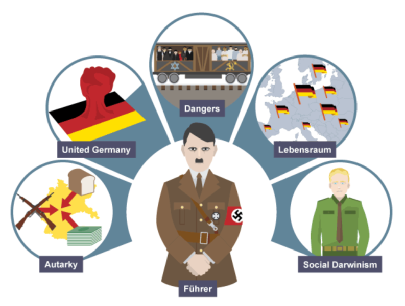 The German people had suffered terribly during both the First World War and the Depression and a huge part of the Nazis’ appeal was that they promised to make Germany’s economy strong again. Hitler aimed for full employment and by 1939 there was virtually no official unemployment in Germany. He also wanted to make Germany self-sufficient, a concept known as autarky, but the attempt to do so was ultimately unsuccessful.
The German people had suffered terribly during both the First World War and the Depression and a huge part of the Nazis’ appeal was that they promised to make Germany’s economy strong again. Hitler aimed for full employment and by 1939 there was virtually no official unemployment in Germany. He also wanted to make Germany self-sufficient, a concept known as autarky, but the attempt to do so was ultimately unsuccessful.
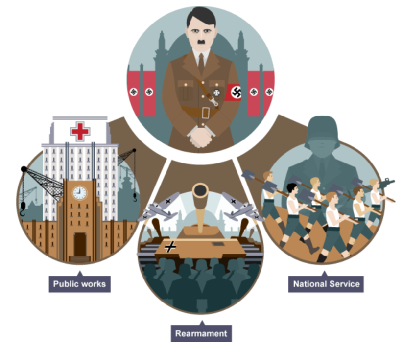 Employment and living standards
Employment and living standards
Three factors of how Hitler increased employment: Public Works, Rearmament and National Service.
He began a huge programme of public works, which included building hospitals, schools, and public buildings such as the 1936 Olympic Stadium. The construction of 7,000 kms of autobahns created work for 80,000 men.
Rearmament was responsible for the bulk of economic growth between 1933 and 1938. Rearmament started almost as soon as Hitler came to power but was announced publicly in 1935.
In 1933, 3.5 billion marks was spent on producing tanks, aircraft and ships, and by 1939 the figure was 26 billion marks. This created millions of jobs for German workers. The use of oil, iron and steel all tripled, creating a variety of different jobs.
Hitler passed the Unemployment Relief Act in June 1933. This helped establish an important organisation, the National Labour Service (Reichsarbeitsdienst (RAD)) which aimed to reduce unemployment and indoctrinate the workforce. Voluntary at first but compulsory from 1935, every man aged between 18-25 had to:
- complete six months training at the RAD
- wear military uniform
- live in camps
- receive pocket money only - no wages
- do military/physical exercise every day such as planting forests and digging ditches on farms
Invisible employment Although Germany claimed to have full employment by 1939, many groups of people were not included in the statistics.
- The were 1.4 million men in the army at this time.
- Jews who were sacked had to give their jobs to non-Jews.
- Women were encouraged to give up their jobs to men.
Autarky The policy of autarky attempted to make Germany self-sufficient, so it would no longer be necessary for Germans to trade internationally. In 1936, Hermann Göring was appointed leader of the Four Year Plan (1936-40). His powers and the plan itself conflicted with Schacht's, the current economic minister, and Schacht resigned in 1937.
The Four Year Plan aimed to speed up rearmament and make Germany self-sufficient to ensure it was ready for war. The measures he introduced, such as tighter controls on imports and subsidies for farmers to produce more food, were not successful. By the outbreak of World War Two Germany was still importing 20 per cent of its food and 33 per cent of its raw materials.
2. IMPACT OF NAZI ECONOMIC POLICIES ON GERMAN PEOPLE
Nazi economic policies had different effects on different economic groups in Germany.
Big businesses - The Nazis had promised to curb the power of monopolies, but by 1937 they controlled over 70 per cent of production. Rearmament from 1935 onwards boosted profits of big weapons companies, and managers of the major industrial companies saw their incomes rise by 50 per cent between 1933 and 1939.
Small businesses - Rules on opening and running small businesses were tightened, which resulted in 20 per cent of them closing.
Farmers - Having been one of the main sources of their electoral support during their rise to power, farmers benefitted under the Nazis. By 1937, agricultural prices had increased by 20 per cent and agricultural wages rose more quickly than those in industry. The Hereditary Farm Law of 1933 prevented farms from being repossessed from their owners, which gave farming families greater security.
Despite the loss of freedom, life improved in Germany for many ordinary people who were prepared to conform in order to have a job and a wage.
3. NAZI POLICY TOWARDS WORKERS
Industrial workers Before 1933 the Nazis had lacked support amongst the workers, who tended to vote for the communists or the Social Democratic Party. The needs of German rearmament made it important that workers were productive and controlled.
The Nazis set up three organisations that would manage German workers.
The Labour Front (DAF) This was a Nazi organisation that replaced trade unions, which were banned. It set wages and nearly always followed the wishes of employers, rather than employees.
Strength through Joy (KdF) This scheme gave workers rewards for their work - evening classes, theatre trips, picnics, and even very cheap or free holidays. The purpose of the KdF was to support the Führer and thank him and to keep everyone happy after abolishing the trade unions.
Dr Robert Ley was in charge of the KdF, and one of its popular schemes was the Volkswagen - the people's car. It was possible to pay for the car in instalments, and the buyer would only receive the car after they had paid the balance in full. When World War Two started in 1939, the car factories had to turn their attention to manufacturing arms. As a result, many Germans lost their money, and there were demonstrations against Ley.
Beauty of Labour The job of this organisation was to help Germans see that work was good, and that everyone who could work should. It also encouraged factory owners to improve conditions for workers. The Beauty of Labour organisation improved conditions in some work places with improved canteens, toilets and sometimes even sports facilities.
The living standards of German workers in the non-armaments industries did not really improve under the Nazis. From 1933 to 1939:
- wages fell
- the number of hours worked rose by 15 per cent
- serious accidents in factories increased
- workers could be blacklisted by employers for questioning their working conditions
4. NAZI POLICIES TOWARDS WOMEN
Nazi views on women and the family
During the 1920s there had been significant progress for women in Weimar Germany - equal voting rights, an increase in women taking professional roles and independent leisure activities.
However, the Nazis had clear ideas of what they wanted from women. They were expected to stay at home, look after the family and produce children in order to secure the future of the Aryan race.
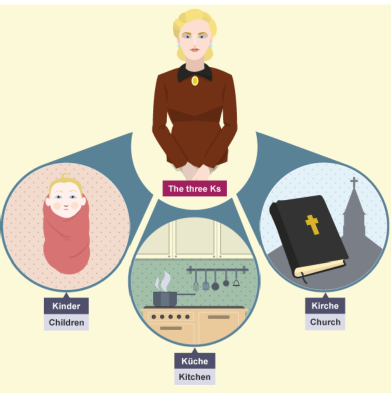
Hitler believed women’s lives should revolve round the three Ks.
The three Ks that Hitler believed women's lives should revolve around:
Kinder (children),
Küche (kitchen)
and Kirche (church).
Marriage and family Hitler wanted a high birth rate so that the Aryan population would grow. He tried to achieve this by:
- introducing the Law for the Encouragement of Marriage in 1933 which gave newlywed couples a loan of 1,000 marks, and allowed them to keep 250 marks for each child they had
- giving an award called the Mother’s Cross to women who had large numbers of children. Women who had 5 children were given a bronze medal. A mother of 6 or 7 children earned a silver medal. A gold medal was awarded to women who gave birth to 8 or more children
- allowing women to volunteer through Lebensborn to have a baby for an Aryan member of the SS
Employment Measures were introduced which strongly discouraged women from working, including:
- the introduction of the Law for the Reduction of Unemployment, which gave women financial incentives to stay at home
- not conscripting women to help in the war effort until 1943
- However, female labour was cheap and between 1933 and 1939 the number of women in employment actually rose by 2.4 million. As the German economy grew, women were needed in the workplace.
Appearance Women were expected to emulate traditional German peasant fashions - plain peasant costumes, hair in plaits or buns and flat shoes. They were not expected to wear make-up or trousers, dye their hair or smoke in public. They were discouraged from staying slim, because it was thought that thin women had trouble giving birth.
5. NAZI AIMS AND POLICIES TOWARDS THE YOUNG
Young people were very important to Hitler and the Nazis. Hitler spoke of his Third Reich lasting for a thousand years and to achieve this he would have to ensure German children were thoroughly indoctrinated in Nazi ideology.
To this end, from the age of 10 boys and girls were encouraged to join the Nazis’ youth organisation, the Hitler Youth (the girls’ wing of which was called the League of German Maidens). Membership from age 10 was made compulsory in 1936 and by 1939, 90 per cent of German boys aged 14 and over were members.
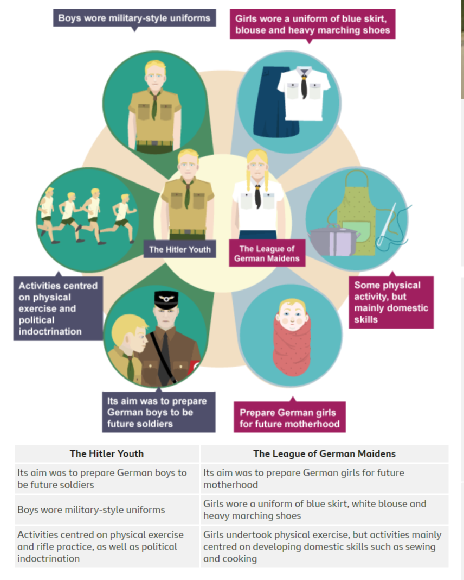
Nazi control of the young through education
As well as influencing the beliefs of young Germans through the Hitler Youth, schools indoctrinated young people in the political and racial ideas of Nazism.
All teachers had to join the Nazi Teachers’ Association, which vetted them for political and racial suitability. Every lesson started with Heil Hitler!
The curriculum was altered to reflect Nazi ideology and priorities.
- History - lessons included a course on the rise of the Nazi Party.
- Biology - lessons were used to teach Nazi racial theories of evolution in eugenics.
- Race study and ideology - this became a new subject, dealing with the Aryan ideas and anti-Semitism.
- Physical Education - German school children had five one-hour sports lessons every week.
- Geography - used to show hostile or racially inferior neighbours and where resources lay that were necessary for Germany's living space, Lebensraum.
Again, the aim was to brainwash children so that they would grow up accepting Nazi ideas without question.
6. RELIGION
Nazi policies towards the Catholic and Protestant Churches There were approximately 45 million Protestants and 22 million Catholic Christians in Germany in 1933. Hitler saw Christianity as a threat and a potential source of opposition to Nazism because it emphasised peace. The Nazis tried to control the Churches with policies and bargaining.
Control of the Churches A state Reich Church under the leadership of the Nazi Bishop, Ludwig Müller was established to unify the different branches of Protestantism. This enabled the Nazis to use a group called the ‘German Christians’ within the Reich Church to promote Nazi ideas.
In 1933 Hitler agreed a Concordat with the Pope, which said that he would not interfere in the running of the Catholic Church if it stayed out of political matters. Hitler didn’t keep his side of the bargain, however, as the Nazis attempted to infiltrate the Church and spread their propaganda.
Nazi attempts to supress the Churches The Reich Church attempted to ban the use of the Old Testament in religious services as it was considered a ‘Jewish book’. Many protestants opposed the Reich Church, and in 1934 Martin Niemöller established the Confessional Church and openly attacked the Nazi regime. He was arrested and sent to a concentration camp in 1937. Eight hundred Pastors of the Confessional Church, a non-conforming Protestant group, were arrested and sent to concentration camps.
The Nazis attempted to stop Catholics using the crucifix in church, though this attempt was not successful. Catholic schools and youth organisations were supressed, with German children being educated in state schools and taught a Nazi curriculum, as well as being expected to join the various branches of the Hitler Youth.
Catholic newspapers were banned and Bishop August von Galen of Munich became a leading voice against Nazis policies. In 1937, Pope Pius XI publicly criticised the Nazis and as a result over 400 Catholic priests were sent to Dachau concentration camp.
Impact of the Nazis actions In 1937, Hitler was forced to return control of the Church to the old Protestant leadership, in return for a promise that the Church would stay out of politics.
Attendance at Catholic churches increased substantially under the Nazis, especially during World War Two, showing that Hitler’s attempts to reduce the influence of religion in Germany were ultimately unsuccessful.
Both Protestant and Catholic clergy played a large role in opposing Hitler and the Nazis, for which they often paid a high price.
7. THE PERSECUTION OF MINORITIES
Hitler and the Nazis had firm views on race. They believed that certain groups were inferior and were a threat to the purity of the Aryan race. There were many groups who were targeted for persecution, including Slavs (Eastern Europeans), gypsies, gay people and disabled people - but none more so than the Jews.
In 1933, there was a small but growing number of black people living in Germany, they were also persecuted by the Nazis. They suffered forced sterilization, medical experimentation, incarceration, brutality and, sometimes, were murdered. However, there was no systematic programme for their elimination as there was for Jews and other groups.
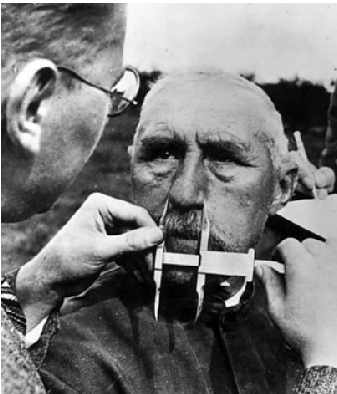 Nazi racial beliefs
Nazi racial beliefs
Image showing a man having his nose measured during Aryan race determination tests under Nazi Germany's Nuremberg Laws that was applied to determine whether a person was considered a 'Jew'.
The Nazis’ racial philosophy taught that Aryans were the master race and that some races were untermensch/sub-human. Many Nazi scientists at this time believed in eugenics, the idea that people with disabilities or social problems were degenerates whose genes needed to be eliminated from the human bloodline. The Nazis pursued eugenics policies vigorously.
Policy of persecution
Sterilisation - In order to keep the Aryan race pure, many groups were prevented from reproducing. The mentally and physically disabled, including the deaf, were sterilised, as were people with hereditary diseases. Children born to German women and French African soldiers in the Rhineland at the end of World War One were called 'Rhineland Bastards' and also sterilised.
Concentration camps - Homosexuals, prostitutes, Jehovah's Witnesses, gypsies, alcoholics, pacifists, beggars, hooligans and criminals were often rounded up and sent away to camps. During World War Two, 85 per cent of Germany's gypsies died in these camps.
THE PERSECUTION OF MINORITIES
Hitler and the Nazis had firm views on race. They believed that certain groups were inferior and were a threat to the purity of the Aryan race. There were many groups who were targeted for persecution, including Slavs (Eastern Europeans), gypsies, gay people and disabled people - but none more so than the Jews.
In 1933, there was a small but growing number of black people living in Germany, they were also persecuted by the Nazis. They suffered forced sterilization, medical experimentation, incarceration, brutality and, sometimes, were murdered. However, there was no systematic programme for their elimination as there was for Jews and other groups.
The Nazis’ racial philosophy taught that Aryans were the master race and that some races were untermensch/sub-human. Many Nazi scientists at this time believed in eugenics, the idea that people with disabilities or social problems were degenerates whose genes needed to be eliminated from the human bloodline. The Nazis pursued eugenics policies vigorously.
Policy of persecution
- Sterilisation - In order to keep the Aryan race pure, many groups were prevented from reproducing. The mentally and physically disabled, including the deaf, were sterilised, as were people with hereditary diseases. Children born to German women and French African soldiers in the Rhineland at the end of World War One were called 'Rhineland Bastards' and also sterilised.
- Concentration camps - Homosexuals, prostitutes, Jehovah's Witnesses, gypsies, alcoholics, pacifists, beggars, hooligans and criminals were often rounded up and sent away to camps. During World War Two, 85 per cent of Germany's gypsies died in these camps.
8. THE NAZIS’ PERSECUTION OF THE JEWS
The group most heavily targeted for persecution by the Nazis were the Jews of Germany. The outbreak of World War Two brought the horror of mass killings and the Final Solution, but the period after 1933 saw a gradual increase in persecution, reaching a turning point during Kristallnacht in November 1938.
1933
- Nazis organised a boycott of Jewish businesses.
- Books by Jewish authors were publicly burnt.
- Jewish civil servants, lawyers and teachers were sacked.
- Race science lessons were introduced, teaching that Jews were sub-human.
1935
The Nuremberg Laws formalised anti-Semitism into the Nazi state by:
- Stripping Jews of German citizenship
- Outlawing marriage and sexual relations between Jews and Germans
- Taking away from Jews all civil and political rights
1938
- Jews could not be doctors.
- Jews had to add the name Israel (men) or Sara (women) to their name.
- Jewish children were forbidden to go to school.
- Kristallnacht - 9 November. The SS organised attacks on Jewish homes, businesses and synagogues in retaliation for the assassination of the German ambassador to France by a Jew.
Many Jews saw the events of Kristallnacht as a turning point. Up until then there had been a progressive erosion of their rights but Jews had not been physically threatened or attacked. When their businesses and homes were destroyed and their synagogues were burnt down, many concluded that their time in Germany was up. Those who were able to fled and a scheme to evacuate Jewish children to Britain, called the Kindertransport, began.
1939
- Jews were forbidden to own a business, or even a radio.
- By the outbreak of World War Two in September 1939, the Jews were stateless, their employment options in Germany were severely restricted and they feared for their safety.
NAZI GERMANY 1933-1939
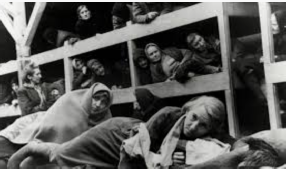
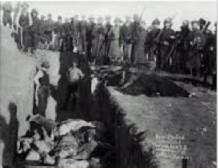
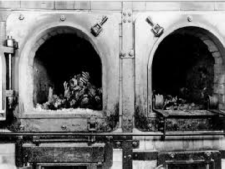
THE
INCREDIBLE
STORY OF THE JEWISH PEOPLE
ADOLF HITLER - RISE TO POWER HD
History Documentaries 2017 (1.09.59)
Adolf Hitler was a German politician who was the leader of the Nazi Party (Nationalsozialistische Deutsche Arbeiterpartei; NSDAP), Chancellor of Germany from 1933 to 1945, and Führer ("Leader") of Nazi Germany from 1934 to 1945. As dictator of the German Reich, he initiated World War II in Europe with the invasion of Poland in September 1939 and was central to the Holocaust.
Hitler was born in Austria, then part of Austria-Hungary, and raised near Linz. He moved to Germany in 1913 and was decorated during his service in the German Army in World War I. He joined the German Workers' Party (DAP), the precursor of the NSDAP, in 1919 and became leader of the NSDAP in 1921. In 1923 he attempted a coup in Munich to seize power. The failed coup resulted in Hitler's imprisonment, during which he dictated the first volume of his autobiography and political manifesto Mein Kampf ("My Struggle"). After his release in 1924, Hitler gained popular support by attacking the Treaty of Versailles and promoting Pan-Germanism, anti-semitism, and anti-communism with charismatic oratory and Nazi propaganda. Hitler frequently denounced international capitalism and communism as being part of a Jewish conspiracy.
By 1933, the Nazi Party was the largest elected party in the German Reichstag, which led to Hitler's appointment as Chancellor on 30 January 1933. Following fresh elections won by his coalition, the Reichstag passed the Enabling Act, which began the process of transforming the Weimar Republic into Nazi Germany, a one-party dictatorship based on the totalitarian and autocratic ideology of National Socialism. Hitler aimed to eliminate Jews from Germany and establish a New Order to counter what he saw as the injustice of the post-World War I international order dominated by Britain and France. His first six years in power resulted in rapid economic recovery from the Great Depression, the effective abandonment of restrictions imposed on Germany after World War I, and the annexation of territories that were home to millions of ethnic Germans—actions which gave him significant popular support.
Hitler sought Lebensraum ("living space") for the German people in Eastern Europe. His aggressive foreign policy is considered to be the primary cause of the outbreak of World War II in Europe. He directed large-scale rearmament and on 1 September 1939 invaded Poland, resulting in British and French declarations of war on Germany. In June 1941, Hitler ordered an invasion of the Soviet Union. By the end of 1941 German forces and the European Axis powers occupied most of Europe and North Africa. Failure to defeat the Soviets and the entry of the United States into the war forced Germany onto the defensive and it suffered a series of escalating defeats. In the final days of the war, during the Battle of Berlin in 1945, Hitler married his long-time lover, Eva Braun. On 30 April 1945, less than two days later, the two killed themselves to avoid capture by the Red Army, and their corpses were burned.
Under Hitler's leadership and racially motivated ideology, the Nazi regime was responsible for the genocide of at least 5.5 million Jews and millions of other victims whom he and his followers deemed Untermenschen ("sub-humans") and socially undesirable. Hitler and the Nazi regime were also responsible for the killing of an estimated 19.3 million civilians and prisoners of war. In addition, 29 million soldiers and civilians died as a result of military action in the European Theatre of World War II. The number of civilians killed during the Second World War was unprecedented in warfare, and constitutes the deadliest conflict in human history.Adolf Hitler Rise To Power
Adolf Hitler was a German politician who was the leader of the Nazi Party (Nationalsozialistische Deutsche Arbeiterpartei; NSDAP), Chancellor of Germany from 1933 to 1945, and Führer ("Leader") of Nazi Germany from 1934 to 1945. As dictator of the German Reich, he initiated World War II in Europe with the invasion of Poland in September 1939 and was central to the Holocaust.
Hitler was born in Austria, then part of Austria-Hungary, and raised near Linz. He moved to Germany in 1913 and was decorated during his service in the German Army in World War I. He joined the German Workers' Party (DAP), the precursor of the NSDAP, in 1919 and became leader of the NSDAP in 1921. In 1923 he attempted a coup in Munich to seize power. The failed coup resulted in Hitler's imprisonment, during which he dictated the first volume of his autobiography and political manifesto Mein Kampf ("My Struggle"). After his release in 1924, Hitler gained popular support by attacking the Treaty of Versailles and promoting Pan-Germanism, anti-semitism, and anti-communism with charismatic oratory and Nazi propaganda. Hitler frequently denounced international capitalism and communism as being part of a Jewish conspiracy.
By 1933, the Nazi Party was the largest elected party in the German Reichstag, which led to Hitler's appointment as Chancellor on 30 January 1933. Following fresh elections won by his coalition, the Reichstag passed the Enabling Act, which began the process of transforming the Weimar Republic into Nazi Germany, a one-party dictatorship based on the totalitarian and autocratic ideology of National Socialism. Hitler aimed to eliminate Jews from Germany and establish a New Order to counter what he saw as the injustice of the post-World War I international order dominated by Britain and France. His first six years in power resulted in rapid economic recovery from the Great Depression, the effective abandonment of restrictions imposed on Germany after World War I, and the annexation of territories that were home to millions of ethnic Germans—actions which gave him significant popular support.
Hitler sought Lebensraum ("living space") for the German people in Eastern Europe. His aggressive foreign policy is considered to be the primary cause of the outbreak of World War II in Europe. He directed large-scale rearmament and on 1 September 1939 invaded Poland, resulting in British and French declarations of war on Germany. In June 1941, Hitler ordered an invasion of the Soviet Union. By the end of 1941 German forces and the European Axis powers occupied most of Europe and North Africa. Failure to defeat the Soviets and the entry of the United States into the war forced Germany onto the defensive and it suffered a series of escalating defeats. In the final days of the war, during the Battle of Berlin in 1945, Hitler married his long-time lover, Eva Braun. On 30 April 1945, less than two days later, the two killed themselves to avoid capture by the Red Army, and their corpses were burned.
Under Hitler's leadership and racially motivated ideology, the Nazi regime was responsible for the genocide of at least 5.5 million Jews and millions of other victims whom he and his followers deemed Untermenschen ("sub-humans") and socially undesirable. Hitler and the Nazi regime were also responsible for the killing of an estimated 19.3 million civilians and prisoners of war. In addition, 29 million soldiers and civilians died as a result of military action in the European Theatre of World War II. The number of civilians killed during the Second World War was unprecedented in warfare, and constitutes the deadliest conflict in human history.
